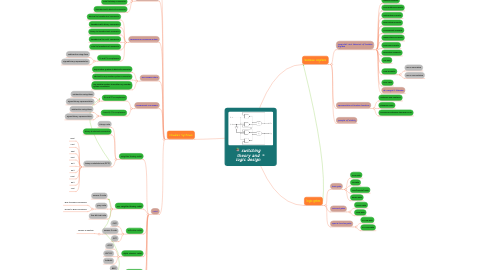
1. Number Systems
1.1. binary numbering system
1.1.1. decimal to binary conversion
1.1.2. binary to octal conversion
1.2. octal numbering system
1.2.1. octal to decimal conversion
1.2.2. decimal to octal conversion
1.2.3. octal to binary conversion
1.2.4. hexodecimalto decimal conversion
1.3. hexadecimal numbering system
1.3.1. decimal to hexadecimal conversion
1.3.2. hexadecimalto binary conversion
1.3.3. binary to hexadecimalc onversion
1.3.4. hexadecimal to octal conversion
1.3.5. octal to hexadecimal conversion
1.3.6. 1's and 2's complement
1.3.6.1. subtraction using them
1.3.6.2. signed binary representation
1.4. any number ystem
1.4.1. any number system to decimal conversion
1.4.2. decimal to any number system conversion
1.4.3. any number system to another any number system conversion
1.5. complement of numbers
1.5.1. 9's and 10's complement
1.5.1.1. subtraction using them
1.5.1.2. signed binary representation
1.5.2. r's and (r-1)'s complement
1.5.2.1. subtraction using them
1.5.2.2. signed binary representation
1.6. codes
1.6.1. weighted binary codes
1.6.1.1. binary code
1.6.1.2. binary to decimal conversion
1.6.1.3. binary coded decimal (BCD)
1.6.1.3.1. 8421
1.6.1.3.2. 2421
1.6.1.3.3. 3321
1.6.1.3.4. 4221
1.6.1.3.5. 5211
1.6.1.3.6. 5311
1.6.1.3.7. 5421
1.6.1.3.8. 6311
1.6.1.3.9. 7421
1.6.2. non-weighted binary codes
1.6.2.1. excess-3 code
1.6.2.2. gray code
1.6.2.2.1. gray to binary conversion
1.6.2.2.2. binary to gray conversion
1.6.2.3. five-bit bcd code
1.6.3. reflective codes
1.6.3.1. 2421
1.6.3.2. excess-3 code
1.6.3.2.1. excess-3 addition
1.6.3.3. 5211
1.6.4. alpha numeric codes
1.6.4.1. ASCII
1.6.4.2. EBCDIC
1.6.4.3. hollerith
1.6.5. sequential codes
1.6.5.1. 8421
1.6.5.2. excess-3 code
1.6.6. error detecting and correcting codes
1.6.6.1. hamming code
1.6.6.2. parity bit
1.6.7. unit distance codes
2. boolean algebra
2.1. properties and theorems of boolean algebra
2.1.1. identity property
2.1.2. commutative property
2.1.3. distributive property
2.1.4. associative property
2.1.5. complement property
2.1.6. idempotency property
2.1.7. inversion property
2.1.8. absorption property
2.1.9. OR laws
2.1.10. XOR property
2.1.10.1. xor is associative
2.1.10.2. xor is commutative
2.1.11. AND laws
2.1.12. de-morgan's theorem
2.2. representation of boolean functions
2.2.1. minterms and maxterns
2.2.2. standard forms
2.2.3. conversion between standard forms
2.3. principle of duality
3. logic gates
3.1. basic gate
3.1.1. AND gate
3.1.2. OR gate
3.1.3. NOT(inverter) gate
3.1.4. buffer gate
3.2. universal gates
3.2.1. NAND gate
3.2.2. NOR gate
3.3. special function gates
3.3.1. EX-OR gate
3.3.2. EX-NOR gate
